Spring pruning fruit trees, timely and correct, is a contribution to the development good harvest, maintaining their health and extending the growing season. There is no difficulty in forming trees. It is enough to learn a few principles. They are applicable for fruit crops, although there are some differences in pruning pome (pear, apple) and stone fruit (plum, apricot, cherry, peach). We'll talk about them later. Now let’s identify the standard provisions for pruning.
Principle 1. In the first years of growth of our young seedling, we form its skeleton, by selective pruning or shortening the annual growth, and promote the development of fruit formations. Next, as our tree ages, we gradually replace existing branches with new ones. Axiom: “A tree lives while it grows.”
Principle 2. We ourselves set the direction of growth. When pruning fruit trees, we direct the branches to where there is free space, making sure that the shoots do not shade each other, do not cross, do not rub, or grow inside our crown. We “discard” such shoots, that is, cut them off. Dry, frozen and damaged ones also need to be pruned.
Principle 3. Our goal is to grow crops, not firewood, so we should limit the growth of trees on the site by finally cutting off the central conductor. We also shorten all skeletal branches. The height of the tree must always correspond to the size at which we can easily collect the fruits.
Principle 4. Sunlight is very important for the ovary and formation of large fruits. The tree, developing and growing more and more new branches, shades itself. Hence, growth slows down or stops, the harvest becomes smaller or does not set. The main task here is thinning. You need to let the sun's rays penetrate through the crown.
Principle 5. Do not forget about the rules of subordination. In the above-ground part, the trunk should be the most developed and powerful. Accordingly, second-order branches in thickness and length should be smaller than first-order branches. It is important that there is only one central conductor and that it is longer in height than the other shoots; competition here is unacceptable. “Pulling the blanket” between competing vertical growths will cause the trunk to bifurcate. At the bifurcation point (slingshot), there is a high probability of a break, which can cause the death of the tree.

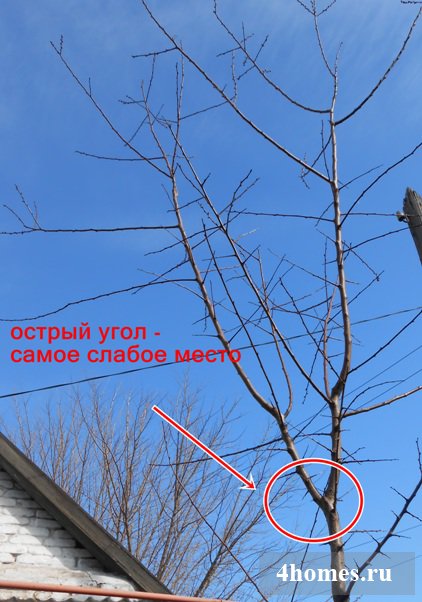
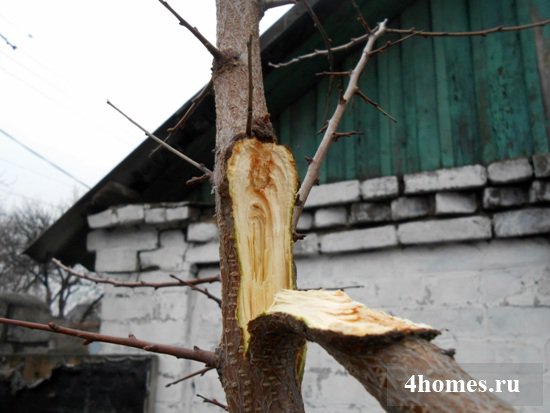
Now directly about pruning fruit trees. We need to understand what and how we will delete. Every tree has a skeletal part. This is the trunk itself and the main branches, arranged in tiers, 3-4 at each level. Skeletal lateral branches usually form as the trunk grows. Lower tier of skeletal branches young tree may already be laid at a height of 60-80 cm from the ground. By shortening the main conductor higher by 80-100 cm from the previous tier, we contribute to the emergence of lateral branches of the new tier.
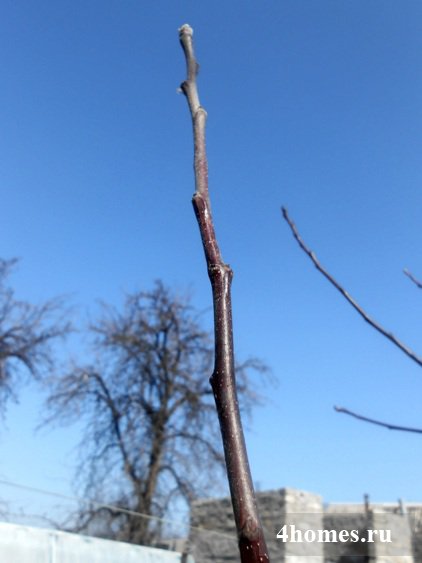
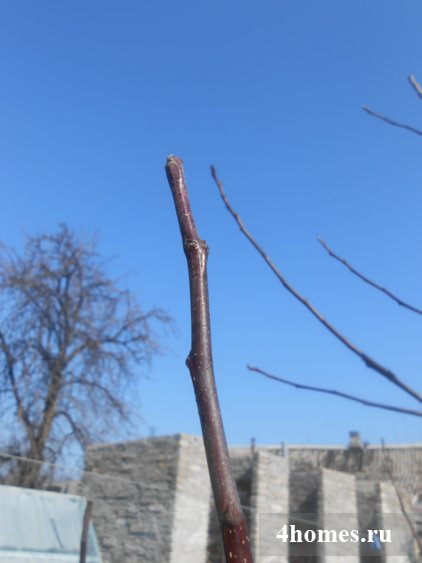
All skeletal branches are located at an angle of at least 45-55° relative to the trunk. If vertically directed shoots appear, they must be removed, since the main task of such shoots is to occupy space; they do not produce fruit.
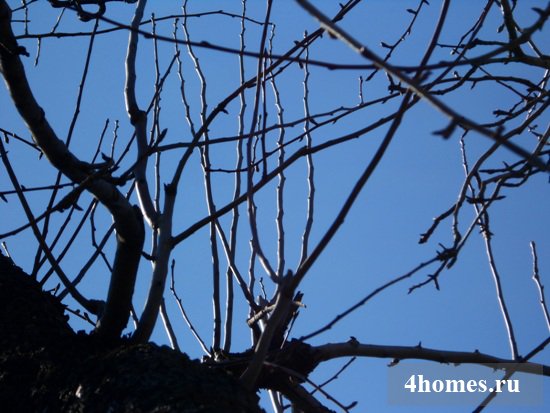
On the central shoot we leave one of these invaders as a continuation of the guide.
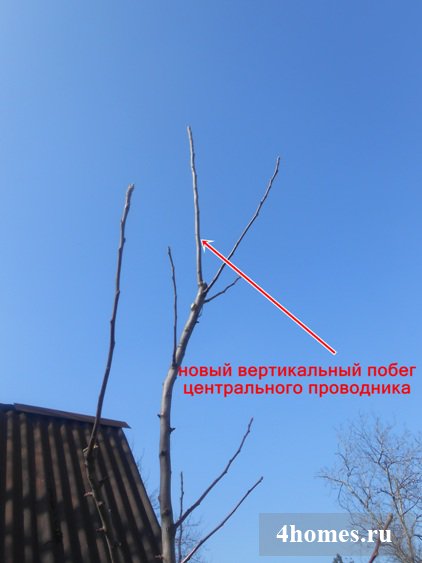
When our tree reaches a height of 3-4 m, we should cut off the top of a two to three year old healthy side branch.
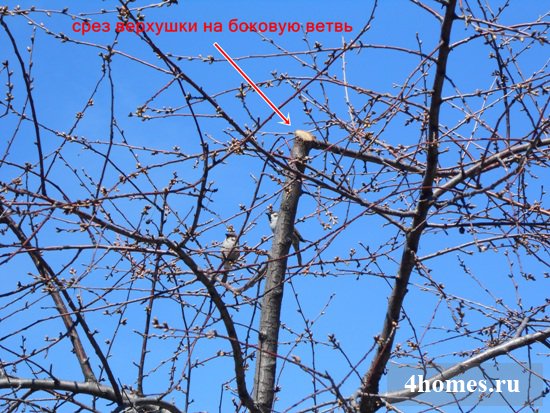
Skeletal, vigorously growing branches are also cut off to one of the weaker side branches. This will limit development in height.
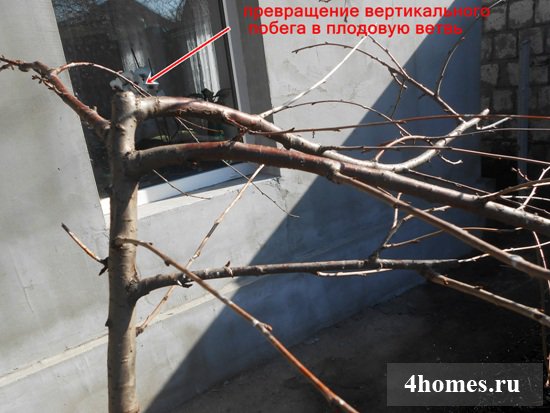

On the skeletal branches (first order) there are semi-skeletal branches (second order). They are also formed by shortening the shoot by several buds.

Moreover, the cut is made directly above the kidney.
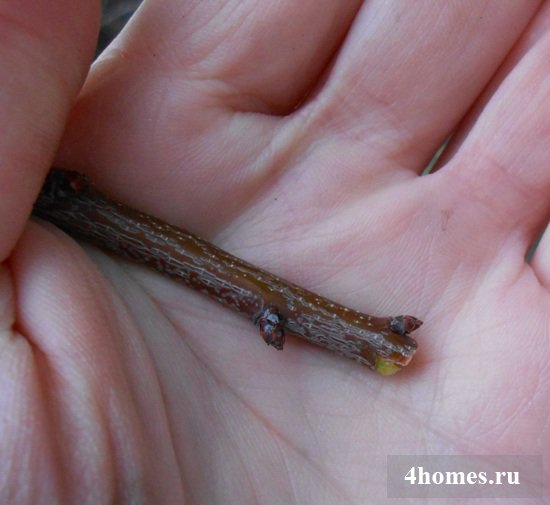
When pruning a fruit tree, we do not leave a stump.
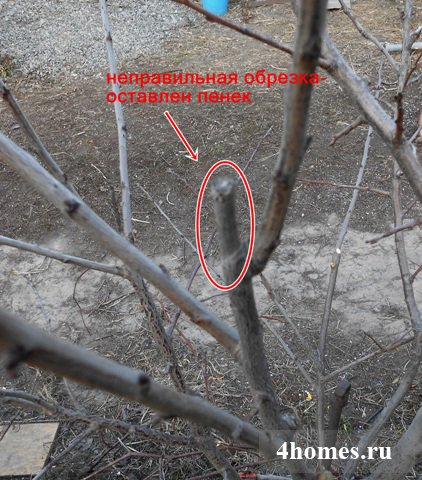
Usually, in any annual growth, after cutting off the top, 3-4 new shoots are formed.
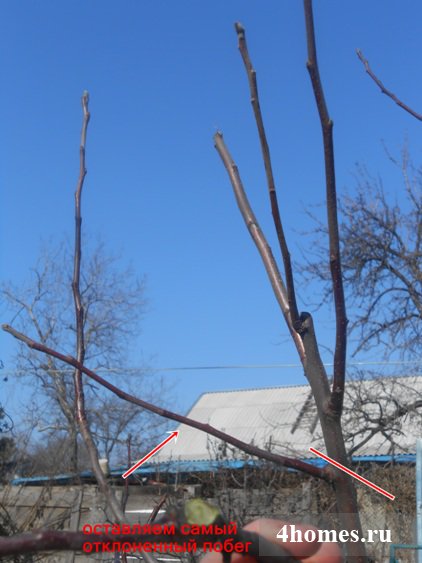
On thicker sections of old branches we can get a much larger quantity.
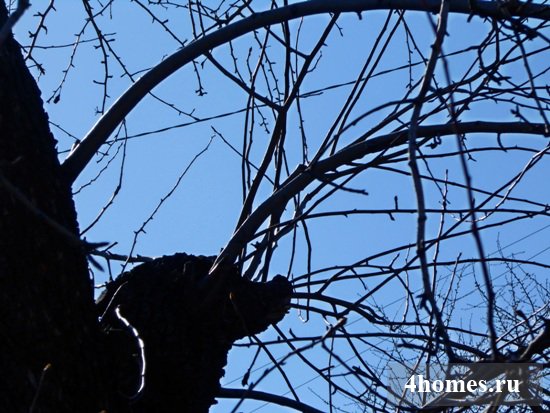
We inspect these branches at the end of the season. We leave the most rejected growths, those located at an acute angle and vertically at the top, fattening (tops), directed into the crown of the tree and intersecting with each other, we remove them.
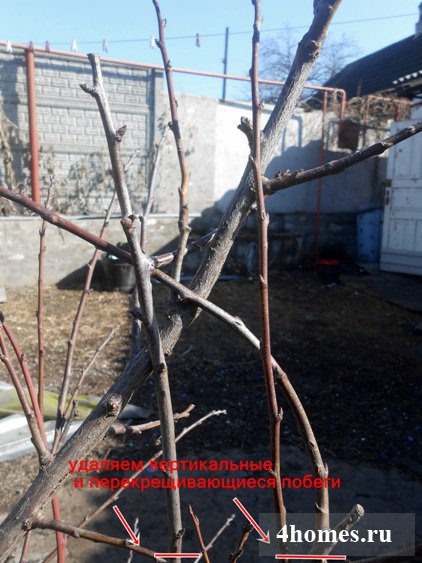
Moreover, we remove it so that the left shoot is, as it were, a continuation of the main branch.



This technique of pruning a fruit tree is also called “plane shaping.” This is how pome fruits are formed. In stone fruits, greater thickening is allowed. You can leave 2-3 shoots on the skeletal part, provided that they are all directed in different directions.
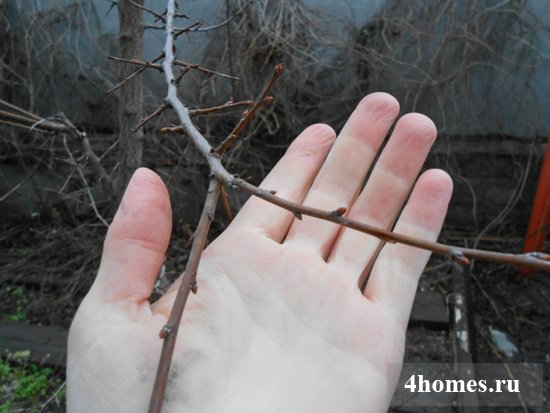
However, like other branches, you need to cut off the shoots on the ring, that is, in the area of a small influx at the base.

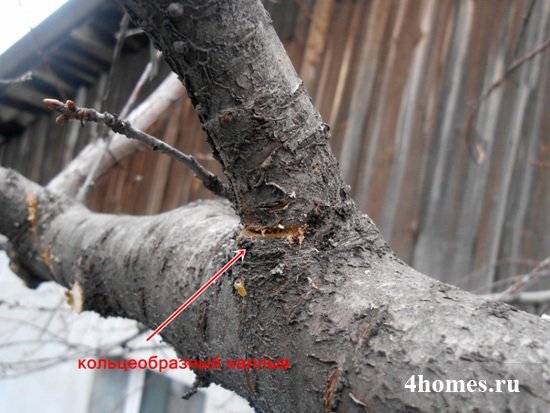
If a branch grows at an acute angle, it does not have this ring.

Therefore, we make the cut so that the inner part goes to the base of the branch, and the outer part forms a small shoulder. Then the cuts heal well. If you leave the stump, it will soon begin to rot and become the main source of the disease. In this place the wood deteriorates and hollows form.

Fruit twigs form on the rejected branches. They look like small even or ringed branches up to 30cm long.


They are quite weak, but they will bear the main harvest. Thinning out excess “freeloaders” in the crown redirects nutrition to these branches.
Over time, our fruits, under the weight of the formed harvest, will be pulled down even more. When the angle of deflection is below 90°, the amount of yield will begin to decrease and the branch will begin to die over time. There is even an “expiration date” for such branches. For apple trees, for example, it is 4-7 years. There are two solutions here: either we cut off the branch completely, or we carry out rejuvenation. We remove it if more powerful branches have grown nearby, and rejuvenation is carried out by cutting our fruiting branch into a shoot that grows at a more acute angle. Having received the main nutrition, it will begin to grow and direct the main branch upward.
The degree of pruning is characterized by the degree of shortening of branches, both skeletal and semi-skeletal. With strong pruning, along with thinning the crown, all growths on the tree are cut off by almost half, and sometimes more, of their length, with medium pruning - by a third, with weak pruning - up to a quarter or not shortened at all. For young seedlings of fruit trees, light or medium pruning is used; strong pruning can delay the period of entry into fruiting. When rejuvenating “elders”, taking into account their condition, they use strong pruning or medium (moderate). Heavy pruning should be used carefully on stone fruits, especially when dealing with thick branches. Large wounds heal poorly in these breeds, and severe or long-term gum formation occurs. This may cause the tree to die. But if you still need to cut out an old large branch, then it is better to cut it on a side branch - above a side young branch or a fairly well-developed bouquet branch.
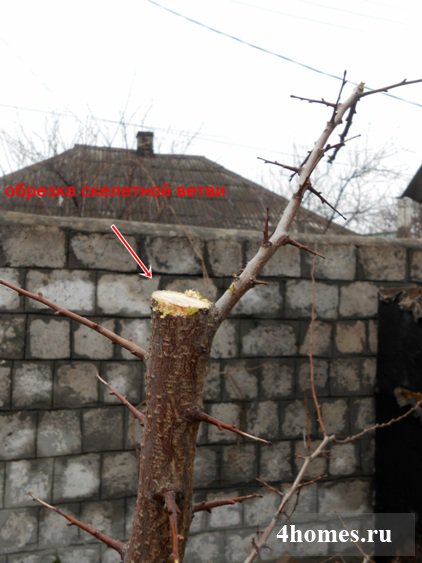
Pome-bearing species tolerate heavy pruning well, growing new growth. Try to avoid deep aging of the branches. This leads to a significant reduction in yield.
We prune fruit trees in early spring, after the severe February frosts have passed and before the buds begin to swell. I do not recommend winter pruning; there is a risk of large sections cracking, drying out and freezing.
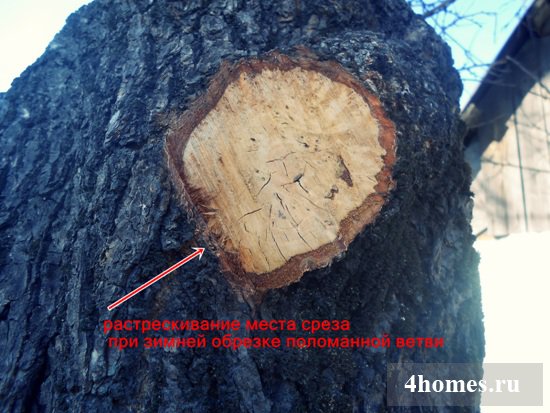
Such places are overgrown quite poorly. Also, with late pruning, when sap flow has already begun, alienation of nutrients occurs.
Stone fruits are pruned only when the weather becomes warm. Apricots still practice new shoots in the summer. In May - June, shoots longer than 20 cm are selected and the tops are cut off. Tall shoots need to be shortened by half, and weak shoots by a third or a quarter of the length. The result of this is the appearance of new shoots of the second wave of growth from the axillary buds of the upper leaves. These growths produce fruit buds for the next growing season. They bloom later than the bouquet branches, but in the event of return frosts, it is these shoots, formed after the summer chasing, that preserve the fruit ovaries, and the tree will eventually produce a bountiful harvest.
And a little about caring for cuts. We remove thin shoots, up to 1 cm in diameter, with pruning shears. More powerful branches are cut with a special curved hacksaw or garden saw. After cutting with saws, irregularities remain on the cut, which must be carefully cleaned with a knife. After cleaning, cover the entire bare surface with garden varnish.

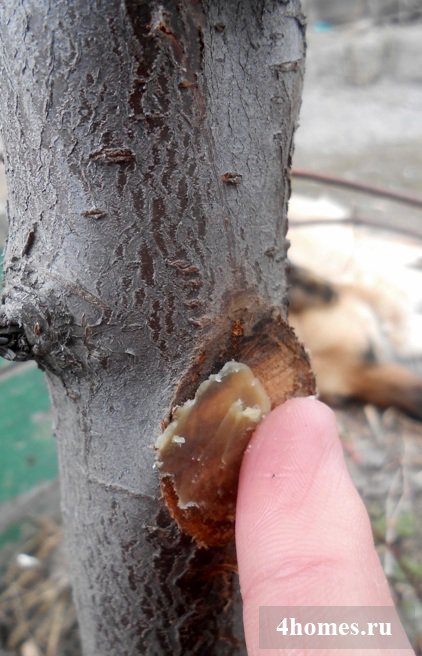
Clay mixed with mullein 1:1 also gives a good effect. This mixture contains growth substances that can enhance the process of cambium division, which will speed up wound healing.
These are the principles we use to prune our fruit trees in the spring.
Pruning is one of the most important procedures for caring for fruit trees. The effectiveness of pruning can increase with systematic and proper care soil care and pest and disease control.
Formative pruning. As a rule, it is carried out for the first 3-4 years. Its main task is to create an easy-to-maintain, well-lit, durable crown, which will speed up the onset of flowering and fruiting, increase decorativeness and yield.
Anti-aging pruning. It is possible to restore the fading growth of old trees, maintain the activity of growth processes, stimulate the formation of generative buds, as well as restore decorativeness and increase productivity. This pruning is carried out after the first 2-3 harvests.
Pruning to reduce height and limit volume. Carried out mainly to improve illumination, as well as increase productivity. It is the most labor-intensive type of pruning.
Sanitary pruning. Carry out in cases with neglected plants that have not been pruned for a long period. The first step is to remove broken and dried branches, parts of drooping branches in the lower zone of the crown. Then we move on to anti-aging pruning and limiting the size of the crown.
Tree pruning in spring
In spring, pruning is carried out at the end of February - at the beginning of April. But at the same time, the weather can make its own adjustments, shortening or extending this period by about one to one and a half weeks.
But, if we talk about more precise timing of pruning, then it is best to carry it out when the plant is at rest. At the same time, we also do not forget to follow the basic rule - pruning is done before the sap begins to flow, that is, before the buds begin to swell.
Trimming methods
There are two methods of pruning: shortening and thinning
Shortening pruning (pruning) involves partially removing the upper part of shoots and branches. Removing from 1/5 to 1/4 of the annual growth is a weak shortening, from 1/3 to 1/2 of a part is medium, 1/2 to 2/3 of a part is a strong shortening.
Shortening branches for 2-3 year old wood (removing the growth of the last 2-3 years) is called rejuvenation or chasing, for 4-6 year old wood - moderate rejuvenation, removal of a significant part of the overgrown wood of skeletal branches - strong rejuvenation.
Pruning technique
When shortening an annual shoot, an oblique cut is made above the bud (on the bud) without leaving a spine. The cut should be on the opposite side of the bud, its lower end slightly higher than the base of the bud, and the upper end at the level of its apex.
When trimming branches, a spine 1-2 cm long is left above the side branch. Thin branches and shoots are shortened with a garden knife or pruning shears, and thick ones with a garden saw.
When thinning, the branches are cut into a ring. The cutting plane in this case should be parallel to the bevel at the base of the branch. A stump should not be left near the influx, as this will make it difficult for the wound to heal. You cannot cut out a shoot or branch below the annular influx, as in this case the area of the wound may increase. When cutting thin branches and annual shoots, the cutting part of the pruning shears, so as not to crush the tissue near the cut, should be directed towards the branch, and not towards the part being cut off.
When cutting with a saw, the branch is sawed first from below, to avoid tearing off the bark below the cut, and is finished by sawing off from above.
Very thick branches should first be shortened and then cut into a ring. The cuts made with a saw are cleaned with a sharp garden knife, achieving a smooth surface.
Wounds more than 2 cm in diameter are covered with garden pitch, oil paint on natural drying oil or a mixture of nigrol and ash (1: 0.3).
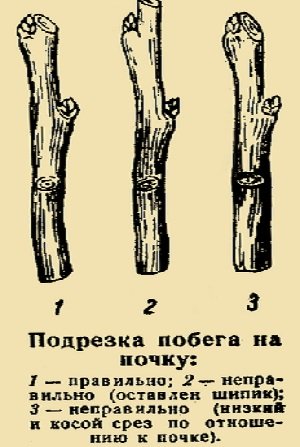
Pruning apple and pear trees that have entered fruiting
At the beginning of fruiting, the formation of skeletal and semi-skeletal branches ends. In the 2-4th year after the completion of the formation of the skeletal branches, a conductor is cut out above the last lateral branch.
This height limitation allows you to have short trees (4-4.5 m) and improve crown lighting. The growth of side branches is also limited by pruning above the side branches.
We prune young fruit-bearing trees minimally. During this period, thinning is mainly carried out in order to remove unproductive semi-skeletal branches. Overlapping, rubbing, intertwining and hanging branches and shoots are also cut out.
In apple trees bearing fruit on ringlets (Antonovka, Grushovka Moskovskaya and similar varieties), as well as in pears, the lateral shoots continue to shorten, but to a lesser extent than before fruiting.
In apple trees that bear fruit on fruit twigs (such as Cinnamon Striped), lateral growth no more than 30 cm long is not pruned.
Pruning apple and pear trees during the period of full fruiting
During the period of full fruiting, the crown of 15-30 year old trees is overgrown with a large number of fruits, and vegetative growth weakens every year.
The branches are so numerous that lack of nutrition leads to the formation of weak ringlets that do not lay fruit buds, and growth shoots barely reach 15-18 cm.
The main task of pruning during this period is to obtain normal (30-40 cm) annual growth, prolong the productive age of fruit formations and maintain the stability of the tree skeleton against fractures under the influence of the weight of the crop.
Shortening the skeletal and semi-skeletal branches has a great effect in solving this problem. The degree of shortening depends on the condition of the trees. For trees that have stopped forming shoots of normal length or form them in small quantities, we shorten 2-3 year old wood.
Skeletal and semi-skeletal branches are pruned at lateral branching. Light rejuvenation is repeated after 3-5 years.

If trees have not produced good growth for a number of years, then all branches are shortened to 3-8 year old wood. The branch should be shortened to the last large growth, cutting it above a lateral branch, a strong ringlet, or at the base of this growth, where there are a large number of dormant buds.
We cut off all the lateral branches on the branch to be shortened by 1/2-2/3 of the length, aligning them with each other. In apple trees with a strongly drooping crown shape (Autumn, striped, Pepin saffron, etc.), the hanging parts of the branches are removed to the branches directed upwards. Strong rejuvenation is carried out at intervals of 5-15 years.
They begin to shorten the branches of periodically fruiting trees regardless of the amount of annual growth. The branches of such trees are shortened during a lean year. The formation of abundant growth caused by pruning diverts a significant part of the nutrients usually spent on the formation of fruit buds. As a result, fruiting becomes moderate.
Trees in which abundant fruiting alternates with small harvests are rejuvenated per year big harvest. When pruning, part of the fruit formations is removed, thereby improving the ratio between growth and fruit wood.
The next year, after shortening the branches, excess shoots that thicken the crown are removed, and the end shoots are shortened. Weak terminal shoots are also shortened so that they do not turn into fruit formations. Branches are formed from the top shoots, if they do not thicken the crown, guided by general principles trimmings. The tops that thicken the crown are greatly shortened or cut into a ring.
To soften the frequency of fruiting of 20-30 year old trees, perennial fruit formations are pruned and shortened, and from 1/3 to 1/2 of the branches of the fruit are removed. The more ringlets there are on a tree, the greater the number of them that are removed. First of all, this applies to apple trees of such varieties as Antonovka, Grushovka Moskovskaya, Borovinka, Anis.
Detailed pruning of pear fruits is especially effective. Any type of pruning of fruit-bearing trees is accompanied by the removal of dry, diseased and unproductive branches from the crown.
Planting a garden is only the first step towards reaping a harvest. In order for it to bear fruit well and not get sick, fruit trees need to be pruned. They do it in spring and autumn. Let's talk about spring. Pruning trees in the spring will help your garden quickly awaken from winter hibernation. At this time of year, nature begins to renew itself. But amateur gardeners have no time to admire the beauty around them. The busiest time is coming for them. It is during this period that most of the work on the plot is carried out. One of these preparatory procedures is spring pruning of trees, which we will discuss in our article.
Timing for pruning
Early spring is considered the best option for such events. At this time, the movement of sap inside the tree has not yet begun, and the plant itself is still sleeping. The right thing to do would be to make sure that winter frosts will not return and only then start cutting off the branches. Otherwise, there is a risk that with the onset of repeated cold weather, the cuttings will cause illness and even death of the plant.
In some regions of the country, later spring pruning of trees is practiced. The procedure is carried out around the end of May. This is done so that the plants can better withstand the summer heat.
Purposes of spring pruning of fruit trees
Trees, like all living beings on our planet, strive to continue their kind. Under natural conditions, this occurs due to seeds. Typically, wild fruit trees are large in size but small in fruit size. This may be good for propagation, but gardeners plant trees for the purpose of harvesting. Over time, an amazing feature was noted: if you remove excess branches, the tree begins to bear fruit better and the size of the fruit also becomes noticeably larger. Since then, great importance has been attached to pruning fruit trees.

Fruit Tree Pruning Tools
By pruning a plant, you injure it. Therefore, it is very important to choose the type and quality of the tool that you use. It depends on them whether the tree will recover quickly.
You will need:
- garden knife;
- pruner;
- hacksaw.
It is recommended to trim the branches with a knife. Secateurs are easier, but they cause more damage: they compress the wood strongly, and then the wound takes longer to heal. In order for the garden to recover faster, the cut must be even. This can only be achieved with a garden knife.

Features of pruning fruit trees
In early spring, garden clearing begins. The growth time of all fruit trees can be divided into 3 main periods:
- Growth period. After successful planting of the seedling in the country and its rooting, the growth period begins. At this time, first of all, its crown actively grows and forms and develops. root system. Outwardly this is expressed in growth vegetative parts tree: branches and foliage. Roughly speaking, the skeleton of the future plant is formed and strengthened. At that time future life and fruiting depends on the formation of its crown. Formation is carried out with the active participation of humans.
- Fruiting period. With the end of the period of active growth, the tree begins to develop reproductive organs and parts. The tree enters the fruiting period. It continues according to the properties of the given variety. After the set period, the plant’s reproductive function begins to gradually fade away: the fruit-bearing branches slowly die off, and instead of them, the vegetative parts - the so-called tops - begin to actively grow. These are vertically growing shoots that practically do not bear fruit, growing closer to the trunk from dormant buds. It is at this time that it makes sense to try to take root cuttings and prepare them for spring planting. The shortening of branches inside the crown stops, the central conductor is cut out, which limits the height of the tree. At this time, pruning is aimed at maintaining the size of the crown.
- Drying period. The last period in the life of a tree, which is gradually accompanied by a decrease in fruiting and ends with the death of the ground part. Very active pruning, aimed at shortening skeletal branches, cutting out all other perennial branches can lead to the development of new lateral fruiting shoots. During this period, it is necessary to actively prepare and grow a worthy replacement for the plant. It should be remembered that it is at this time that the active growth of root shoots (offshoots) begins.
Approximately according to this principle, all fruit trees in the garden develop, which means that pruning should be appropriate.

Scheme for pruning fruit trees in spring
As a standard, gardeners apply the following basic rules for cutting fruit trees:
- It is unacceptable to cut off the central trunk of large crops; it is cut off only in dwarf varieties.
- It is necessary to cut off secondary branches.
- Branches that move into the crown as they grow should be removed.
- Branches that thicken the crown (highly branched) must be removed.
- It is necessary to cut off annual shoots - tops.
- If branches grow downward, they are also removed.
- It is necessary to cut off wild shoots growing from the rootstock.
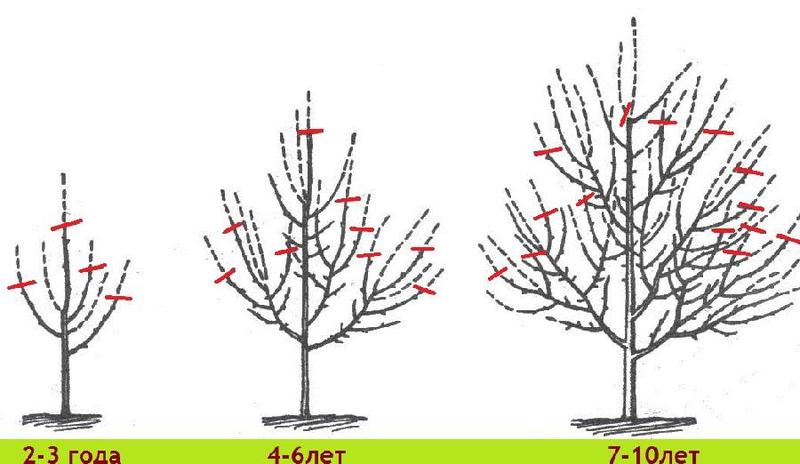
Common mistakes when pruning fruit trees
- do not use garden varnish to putty cuts or wounds on trunks;
- It is not recommended to use oil paint and other preparations for putty (these recommendations have been scientifically proven to be erroneous; moreover, they can seriously harm the health of the tree);
- wounds and hollows cannot be cleaned mechanically “to the point of healthy wood”; this will worsen the condition of the tree;
- To extend the life of a tree, do not fill hollows (cement or seal them with sealant), or drill drainage holes;
- in order to avoid breaking the tree or “strangling” it, do not tighten cracked branches and trunks with clamps, wire, cables, etc.,
- If there are too many fruits and there is a danger of branches breaking, it is not recommended to install supports or braces. It is best to pick off some of the fruits, but if the stretch marks are already standing, be sure to remove them after the fruits are picked or fall off, otherwise the tree will “get used to it” and will no longer be able to stand on its own without supports.
How to replace spring pruning of fruit trees
It is not always necessary to prune a fruit tree. There are a number of ways to replace it, for example, blinding the buds, picking, ringing, pinching, changing the orientation of the branches in space. If a branch is not required in a certain area, and in its place there is already a clearly visible bud from which a branch will definitely grow, then you should blind it without waiting for growth to begin. Additional buds nearby should also be removed. During the process of forming the crown of young plants this method is effective. In old trees, pruning is usually replaced by breaking off shoots, but it is better to do this for the first time summer days, because the shoots are still short and not woody.
Pruning fruit trees in spring
- crown formation;
- stimulation of the formation of fruiting shoots.
Gardeners pay the closest attention to their favorite fruit crop - apple tree . Tree pruning is carried out almost throughout its entire life. garden plot, but in different age periods fruit crop The method and purpose of this event differ.
Formation of the crown frame of young apple trees
Young apple trees should be pruned on warm March days after settled snow. This work can be continued after the ground is free of snow, but has not yet become soggy, as gardeners say, “over a shard.” Later, at the beginning of April, the buds awaken, and by this time the formation of the crown of the young tree should be completed so as not to provoke a delay in spring development.
"One-year-olds"
Already in the first spring after planting the apple tree, pruning must be done, regardless of whether the tree was planted last spring or autumn. The first pruning is primarily necessary for:
- eliminating the disproportion between the development of the root system and the above-ground part. (This imbalance arose at the time of replanting, when the roots were shortened, but the above-ground part remained unchanged);
- formation of the crown skeleton.
If the seedling was one year old, then most likely it has no side shoots . In this case, it is cut at a height of 0.8 to 1 m from the ground. Thanks to this, side shoots will begin to appear this season, and next year it will be possible to begin forming the crown.
If there are already side shoots , then those of them that are at a height of up to 50–70 cm must be removed. Those remaining above this level should be sorted: get rid of those that form an acute angle with the main stem, and shorten the rest (by the 3rd–5th bud from the base of the shoot). The upper part of the barrel (conductor) also needs to be shortened. In this case, you need to make sure that it remains 15–20 cm longer than the side branches. That is why this main shoot is called the leader.
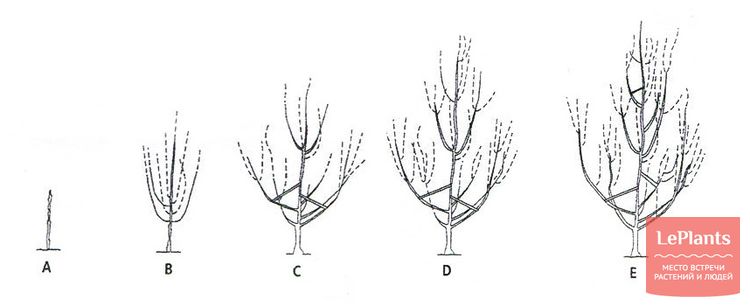
A. A seedling immediately after planting.IN. The first tier of skeletal branches and the centering of the leader (central conductor).WITH. The first tier of branches is installed in the desired position (at an angle of 45° in the figure), and the adjustment of the second tier begins. D And E. Branches develop in the third and subsequent years in the space around the central conductor. Only weakened and broken branches are pruned.
Branches growing almost vertically upward at an acute angle to the main trunk are removed due to the fact that they subsequently shade the central part of the crown and most often break off under the weight of the fruit. In cases where the gardener still needs to preserve these branches, he needs to make sure that they grow almost horizontally in relation to the surface of the earth. You can do this in several ways:
- pull with ropes tied on one side to a branch, on the other to hooks driven into the ground or to the tree trunk itself;
- place a wooden spacer or a suitable-sized pebble in the corner between the side shoot and the main trunk.
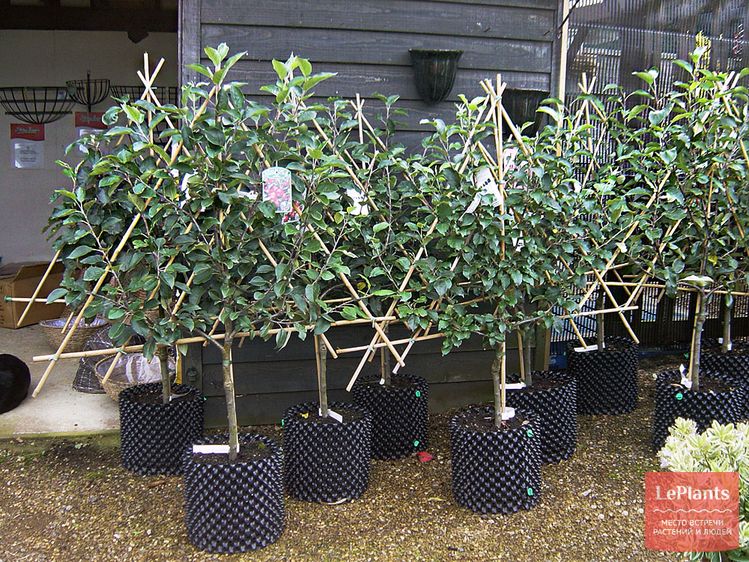
"Two-year-olds"
The principle of pruning a two-year-old seedling is the same. This young tree usually consists of a main stem and several lateral branches. Three to five of the thickest branches, growing at a wide angle to the central trunk, should be left. In the future, these will be the main branches of the apple tree. All other shoots are completely cut out. Those that are left must be shortened in accordance with the following hierarchy:
- leave the lower shoots up to 30 cm long;
- The branches of each next tier located above should be slightly shorter than the previous one;
- the leader should be 15–20 cm longer than the tops of the side shoots of the uppermost tier.

No pruning is required for the next 3-5 years, except to remove broken or diseased branches. If the tree grows too vigorously, the central shoot stretches so quickly that there is too much space between the side layers. In this case, it is advisable to shorten the conductor, not forgetting that it must remain a leader, i.e. located above the ends of the side branches. Otherwise, shortening shoots during this period is categorically not recommended, since this can only slow down the onset of fruiting.
Pruning fruit trees
An adult fruit-bearing tree also needs to be pruned regularly. This is done to:
- provide light access to the central part of the crown;
- stimulate shoot growth;
- reduce the height of the tree and form a compact crown that is convenient for processing.
Adult fruiting apple trees, unlike young trees, can be pruned during the flowering period and a week after it. And cutting out large branches and pruning the conductor in order to reduce the crown is recommended to be done precisely during flowering and its end.
There are two methods for pruning mature trees: thinning and shortening. In the first case, the branches are completely removed so that there is no stump left protruding on the conductor. In the second, part of the branch is cut off. In both cases, you should adhere to the rule: remove and trim the large branches first, and then the smaller ones. This is due to the fact that after removing large branches it will become clear whether smaller ones need to be removed. In addition, it is preferable for the health of the tree to make one large cut rather than several smaller ones.
Thinning
Pruning begins with thinning, opening the central part of the crown. To do this, at a selected height, above one of the branches, the central conductor trunk with all its lateral branches is cut down. This procedure, firstly, opens access to sunlight to the inside of the crown, and secondly, reduces the height of the tree.
Then, from top to bottom, they begin to cut out excess branches: dry and damaged, one of those crossing or rubbing with each other, with the direction of growth inward of the crown.
After this, they move to the thickest parts of the crown.
Thus, main function of thinning - improving access of light inside the crown. Thanks to this, the fruits will develop evenly throughout the entire crown, and not concentrate on the periphery, which is why the branches can break off under their weight. In addition, the apples will hold on to the stalks more firmly, without falling off at the first wind, and the sun's rays freely penetrating to them will help improve taste qualities. The second advantage of thinning is that access to light will stimulate the formation of flower buds, and this is the key to a good harvest next year.
How to cut branches correctly?
The main rule is that when removing branches there should be no protruding stumps. They subsequently rot, break off, and a hollow forms in their place. You cannot cut a branch close to the trunk: then a too large wound will form, which can lead to the destruction of the trunk inward. The correct cut of a side branch should pass along the bead ring - a circular thickening at the base of the branch.
Large branches are easier to cut down fine-tooth hacksaw , placing the tool not from above, but from below. To avoid tearing off the bark from the trunk when breaking off a sawn-off branch, after sawing from below, you need to saw from above. When sawing off a thick branch, it may break off closer to the trunk than necessary or even break off part of it. To prevent this from happening, they cut, first leaving a long stump, and only then trim it along the edge of the influx. Small branches are removed with garden pruners. Also, instead of a hacksaw, it is permissible to use a large garden pruner, as in the video below.
After pruning, all wounds should be coated with garden varnish or paint. If the branches were dead, then this is done immediately. When trimming living branches, it is better to cover the cuts with paint every other day, when their surface has dried a little. In this case, the paint will adhere better and protect the wound from the penetration of harmful microorganisms and moisture.
Shortening branches
Once thinning is complete, it’s time to start shortening branches and annual shoots. This measure contributes to:
- Strengthening the nutrition of the remaining kidneys.
- Formation of new shoots.
- Improvement of illumination in the crown.
Branches are cut strictly at the branching point. Annual non-branching shoots are cut obliquely above the bud so that the cut surface is parallel to the axis drawn from the top to the base of the bud.
In this case, as usual, a tiered hierarchy should be observed: the shoots of each higher-growing tier must be higher than the shoots of the underlying tiers. The leader shoot should always be longer than the stems branching from it. Too thick crowns are thinned out two to three years in advance so that the apple tree does not get sick from too many wounds. Maintenance pruning should then be carried out annually. As a result, after pruning and shortening, you should get a crown through which, as people say, a sparrow can fly in winter, i.e. The branches should be positioned fairly freely.
Before you start pruning, you need to mentally imagine an action plan: which branches will need to be removed, which ones will need to be shortened. Only then should you begin to work directly with a hacksaw and pruning shears, making adjustments as the results of pruning become noticeable. Shortening the shoots must be completed before the buds begin to grow. At the apple trees middle lane In Russia this usually happens in early April. It will be possible to remove large perennial shoots that were mistakenly left in the summer, when the greenery blooms and it becomes clearly visible which branches create shading.
Crown reduction
As for the crown, it should be said that systematic pruning of its upper part should be done regularly, from the sixth to eighth year after planting the tree in the garden. This helps to improve the quality of the fruit (due to free access to sunlight), the formation of a compact crown, convenient for harvesting and processing.
Despite the systematic pruning of the top, at the age of approximately twenty to twenty-five years, a more significant reduction of the crown should be done. The technique and procedure for carrying out this work are as follows:
- Cut out the top of the trunk with one or two powerful lateral branches of the first order (extending directly from the trunk). This needs to be done at a height of 2–2.5 meters.
- Shorten the remaining upper branches at the same level.
As a result of this agrotechnical measure, access to the sun's rays opens up in the central part of the crown. But at the same time, many shoots begin to grow, which form a “brush” over the cut part. These shoots are called tops, and they will need to be removed in time. Otherwise, they will form such dense thickets that they will hinder the access of light to the crown even more than before the top was removed.
Removal of tops should also be done correctly: you cannot cut them all off at once. A large number of wounds, even small ones, can harm the tree. Therefore, you should do this in two or three steps. The thickest ones that grow vertically are cut off first. But on the contrary, it is advisable to leave some of the tops located more horizontally. These shoots are able to quickly switch to fruiting, which will further intensify after pruning the tops located above. The remaining tops need to be bent even further to a horizontal (maybe even slightly lower) level. How to do this has already been said above.
Cutting tops is quite inconvenient. There is one way to make this job easier - breaking it out. To do this, you need to take a stick and tie a hook sharpened on the inside to it. With this tool you need to grab the top at the base and break it out with a sharp jerk. This work should be done in late May - early summer, when the shoots have not yet become woody.
Rejuvenation of old apple trees
Sometimes gardeners are in no hurry to get rid of old apple trees for some reason, for example, if it is a valuable variety that has nothing to replace it with. Increase the yield old apple tree possible using rejuvenation - a special pruning technique. The actions are performed in the same way and according to the same rules as when thinning the crown, only you need to remove the maximum number of branches. In this case, the branches should be shortened by no less than two-thirds of their length. As with lightening the crown, many tops begin to grow. They also need to be removed, leaving the growing ones more hollow, further pulling them back. These shoots should be greatly shortened for two to three years in a row to stimulate fruiting.
When rejuvenating pruning, it is imperative to leave one skeletal branch untouched for 2–3 years. The leaves growing on it will intensively photosynthesize, supplying nutrients to the entire tree until a new full-fledged crown develops from the remaining tops.
Another rule that gardeners should remember: pruning should only be done on healthy trees. In weakened trees, wounds heal slowly and there is a high risk of infection. As a result, the tree may wither and die.
Do cherry and plum trees need to be pruned?
There is an opinion that cherries and plums tolerate pruning worse. This is not entirely true. We are talking only about sick and weakened plants. As a result of pruning, pockets of gum growth may appear in their wood, which can lead to the death of shoots and weakening of the tree. Therefore, for such specimens, you should limit yourself to only pruning branches that greatly thicken the crown.
